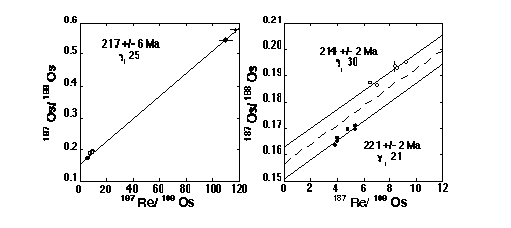
The Ivrea-Verbano zone (western Alps, NW Italy) is predominantly made up by metasedimentary rock types (the Kinzigite formation) intruded by a suite of Permian gabbro (Mafic Complex). Some alkaline ultramafic pipes cut across the metasedimentary rocks and the youngest mafic intrusive. We investigated one of these pipes (Valmaggia pipe in Val Sesia, Italy). This pipe (an old Nickel mine) is made up of Hbl-Bt-Ol-Cpx-Opx-Sp±Pl with variable amount of ore minerals. During a late magmatic metasomatic event, hornblende and biotite reacted with olivine producing an Opx+Sp reaction rim. The ore assemblage is quite complex (py-po-pn-cp-mck-cb, Pd-Pt tellurides, hessite, altaite, wehrlite, electrum and Ni-Co-Fe-Ir sulfarsenides) and ores mainly formed by subsolidus exsolution from monosulfide solid solution. Locally, the mineralisation is mobilised along brittle structures and enriched in Cu.
A whole rock and mineral separate (n=15) Re-Os isochron gives an age of 217 ± 6 Ma with g(Os)=25 (Fig. 1). The initial ratio is very high compared to mantle composition. A sample from a remobilised zone gives a Re-Os isochron age of 214± 2 Ma, but with a more radiogenic initial (Fig. 1). The host gabbro gives a Re-Os model age of ca. 320 Ma. Whole rocks and mineral separates (n=10) define a Rb-Sr errorchron of 195 ± 9 Ma. Hornblende, due to Ar excess, only defines a maximum emplacement age of ca. 280 Ma (n=3). Biotite constrains the Jurassic exhumation (Ar-Ar ages from 177 to 181 Ma; Rb-Sr ages from 190 to 210 Ma).
Whole rocks are light-REE enriched with positive Eu anomalies that correlate with LILE enrichment and ore grade. Whole rock Os and Re concentrations range from 0.02 to 236 ppb, and 0.1 and 151 ppb, respectively. The high g(Os) may be interpreted as crustal contamination. However, continental material has a high Os isotopic ratio but low concentration which requires a mixing process able to efficiently extract crustal Os and mix it with the source or magma at a pre-emplacement stage. Pb isotopes do not evidence large crustal contamination. Initial (220 Ma) Nd (from 1.8 to -3.5) and Sr (from 0.70519 to 0.70728) isotopic compositions also define a mixing curve between mantle and crustal components (the host gabbro is not one of the possible end members). Initial Nd, Sr and Os is directly related to ore grade.
We suggest that ore genesis and pipe emplacement are related to the same Triassic event and that the Re/Os isotopic system allows a precise dating of ore deposits. The cooling history (Triassic and Jurassic) of the Valmaggia pipe is consistent with that of the surrounding gabbro. The Triassic alkaline magmatism may be interpreted as one of the first signals of the Jurassic extensional tectonic regime responsible for the break-up of the Variscan continent.